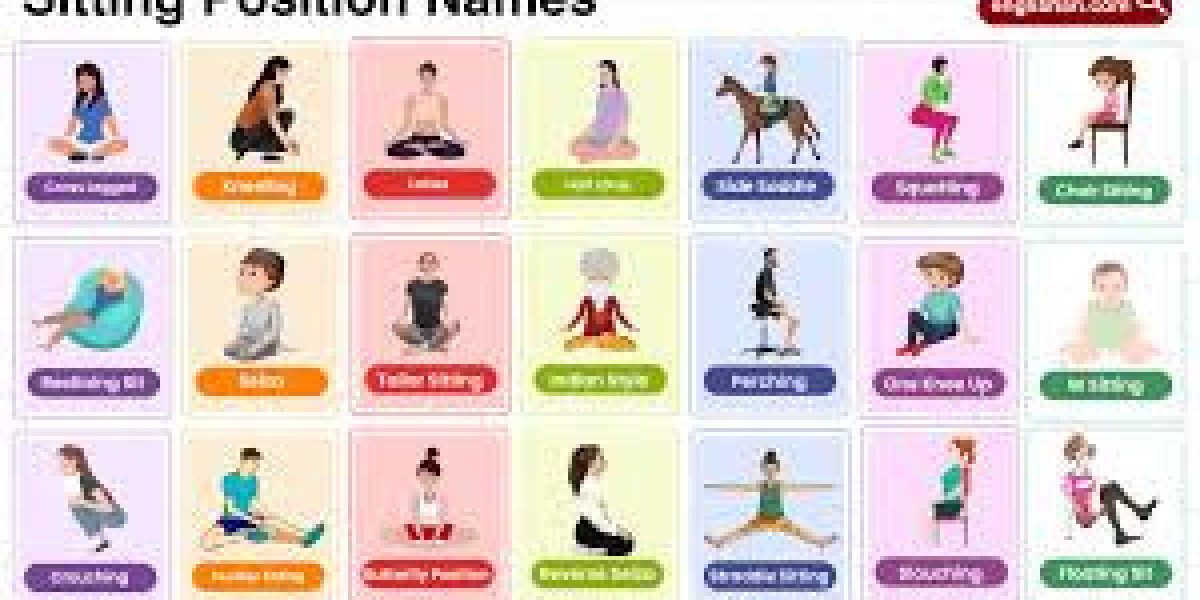Overview
We sit in many ways throughout the day—at work, while eating, during meditation, or while watching TV. But how often do we think about our sitting position? Knowing the correct sitting positions names is not only useful for posture and health, but also important for yoga, ergonomics, and even cultural awareness.
In this article, we will explore the different sitting positions names, their uses, meanings, and benefits.
Why Sitting Positions Matter
Most people sit for long hours every day. Whether you are working at a desk or relaxing at home, the way you sit can affect your:
Spine health
Joint flexibility
Digestion
Energy levels
Choosing the right sitting position can prevent back pain, boost your focus, and improve overall well-being. Let’s explore the most common and helpful sitting positions names in easy-to-understand language.
1. Cross-Legged Position (Sukhasana)
This is one of the most traditional sitting positions, especially in yoga and meditation practices. In this position, you sit on the floor with your legs crossed and back straight.
Where it’s used: Yoga, meditation, cultural rituals
Benefits: Improves posture, opens hips, and promotes relaxation
Tip: Place a cushion under your hips for comfort.
2. Lotus Position (Padmasana)
The lotus position is a more advanced version of sitting cross-legged. In this pose, each foot rests on the opposite thigh.
Where it’s used: Deep meditation, advanced yoga
Benefits: Increases focus, balances energy, and improves flexibility
Note: It may not be suitable for beginners or those with knee issues.
3. Chair Sitting (Neutral Sitting Position)
This is the most common sitting posture used at offices, homes, and schools. Sit upright with both feet flat on the ground, knees at 90 degrees, and back straight.
Where it’s used: Office work, driving, meals
Benefits: Supports spine alignment and reduces fatigue
Tip: Use an ergonomic chair for better support.
4. Seiza (Japanese Kneeling Position)
Seiza is a traditional Japanese way of sitting where you kneel on the floor with your legs folded under your thighs and buttocks resting on your heels.
Where it’s used: Japanese tea ceremonies, martial arts, formal rituals
Benefits: Encourages upright posture and calmness
Caution: Not recommended for long durations without breaks.
5. Squatting Position
This involves bending your knees fully with your feet flat on the ground and your body resting in a squat.
Where it’s used: Many Asian and African cultures, exercise routines
Benefits: Improves hip mobility, aids digestion, and strengthens legs
Note: It's natural but may feel uncomfortable if you’re not used to it.
6. W-Sitting
This is when someone sits on the floor with knees bent, feet tucked behind on both sides of the hips, forming a "W" shape.
Where it’s used: Mostly seen in young children
Risks: Long-term W-sitting can cause joint strain or hip issues
Advice: Encourage alternative sitting postures in children.
7. Butterfly Position
In this posture, you sit with the soles of your feet pressed together and knees dropped to the sides, forming a diamond or butterfly shape.
Where it’s used: Yoga, stretching, prenatal exercise
Benefits: Opens inner thighs and hips, improves flexibility
Tip: Gently press the knees down to deepen the stretch.
8. Reclined Sitting (Semi-Fowler’s Position)
This is a semi-lying down sitting position with the upper body elevated at an angle of 30–45 degrees.
Where it’s used: Hospitals, reading in bed, post-surgery rest
Benefits: Reduces strain on the lower back and aids breathing
Ideal for: Patients and elderly people who need back support.
9. Side Sitting
This casual position involves sitting with legs folded to one side. It is often seen in formal traditional settings or as a relaxed way to sit.
Where it’s used: Home, cultural events, photography poses
Benefits: Graceful posture, but not ideal for long periods
Tip: Alternate sides to avoid muscle imbalance.
10. Legs Forward Sitting (Dandasana)
Sit on the ground with legs stretched straight forward and back upright. This is a foundational yoga pose.
Where it’s used: Yoga, stretching, physical therapy
Benefits: Strengthens back, improves body awareness, aids digestion
Tip: Engage the core to hold posture longer.
Related more articles, plant names for boys
Summary Table: Common Sitting Positions and Their Uses
Sitting Position | Common Use | Key Benefit |
Cross-Legged | Meditation, yoga | Calms mind, opens hips |
Lotus Position | Advanced yoga, deep focus | Enhances energy, flexibility |
Chair Sitting | Office, home | Supports spine, reduces fatigue |
Seiza | Traditional Japanese events | Improves posture and discipline |
Squatting | Rest, outdoor work | Strengthens lower body |
W-Sitting | Children playtime | Not recommended long-term |
Butterfly | Yoga, stretching | Opens inner thighs, improves range |
Reclined Sitting | Bed rest, hospital | Reduces back pressure |
Side Sitting | Casual, cultural | Relaxed but not ergonomic |
Legs Forward Sitting | Yoga, stretching | Builds core, aids posture |
Tips for Healthy Sitting
Change your position regularly – Avoid sitting in one position too long.
Support your back – Use a cushion or ergonomic chair.
Keep feet flat – Especially while chair sitting.
Stretch between sitting sessions – Prevents stiffness and pain.
Avoid slouching – Always keep your spine aligned.
Final Thoughts
Knowing different sitting positions names helps you make better choices for health, comfort, and cultural respect. Whether you are meditating in Lotus, working in a chair, or relaxing in Seiza, the right posture can improve how your body feels and functions.
By practicing good sitting habits and learning these positions, you can support both your physical health and mental well-being. So, the next time you sit down—whether on a mat, chair, or floor—remember that how you sit really does matter.
more related articles, visit here








